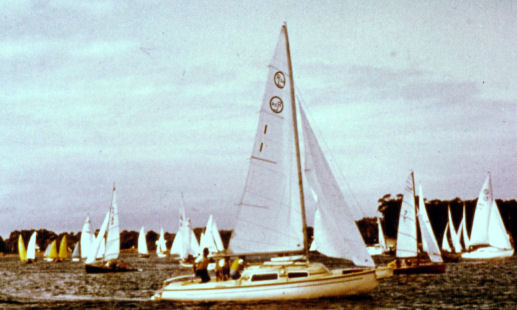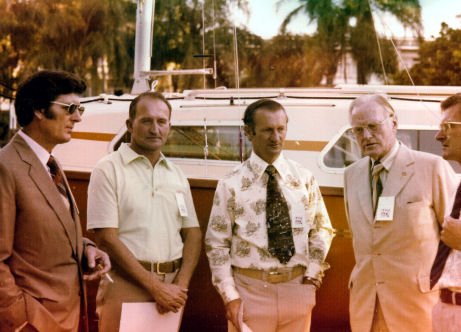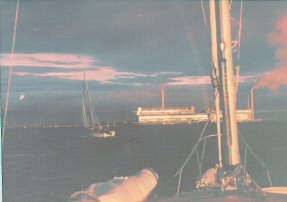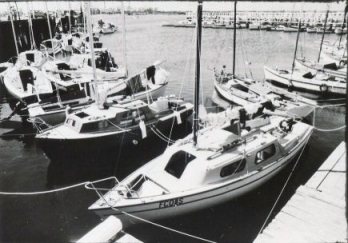It was like being the fastest gun in the west!
After the Dragon incident, a Sydney based boating magazine organised a challenge race between ourselves and
the top Timpenny on Botany Bay. We did the ten hour trip and arrived at the boat ramp but no Timpenny appeared.
After some phone calls, it appeared that our rival had broken some gear the day before and couldn't race.
The organisers not wanting to waste the opportunity then suggested that we participate in a self righting test.
Self righting was a hot topic for trailable yachts at the time as keel boat classes were being rather critical.

Paynesville Easter 1975, always great hospitality and great sailing waters, even if it is subject to the south
westerly cold fronts that sweep up from the South Pole.
I had known Eric Maisey, the designer of the Boomerangs, since the Melbourne days when he was a traveller for a
ships chandler. He was giving us a hard time over the self righting ability of our boats. He also claimed that
his Boomerangs were faster as well. After some verbal skirmishes we arranged to meet and sort it out at the
Paynesville Easter regatta. We trailed Tiki the 1,600 Km down to Paynesville and arrived just in time to get
ready for the first race, but we couldn't see any sign of a Boomerang. I was very embarrassed that evening when
it was explained to us that Eric had died the week before after suffering a heart attack on board his boat.
These photos were sent to me of another righting test done in Sydney, by Mike Stevens.
They are shown in reverse order (when the boat was being hauled down) because the self righting from horizontal
to vertical only took two seconds, and it was too quick to catch on camera.
By the tests that we did, it appeared that there was a distinct danger of a crew member being thrown off the boat
because it righted so fast.
So if it happens to you, HANG ON TIGHT!
There is always a potential danger in very bad conditions, and especially with a strong tide flowing in against
the wind, of the mast spearing in to the back of a wave, and the sail preventing the boat from righting.
A test was done to try and sink a Mk 1 RL24. First the boat was pulled down on its side until the water came in over the coaming, but the water still
wouldn't come into the cabin. Frustrated with this, a fire pump was hired to fill the boat but the water
just flowed out over the sill at the cabin entrance and on out through the outboard cutout.
We were surprised to learn that our boat had been nominated for a good design award and we agreed to take part in
the necessary tests. The boat had to be completely stripped and inspected, then rigged and sailed, and the
self righting ability checked. They looked at every thing, and even measured up the volume of sealed compartments
for reserve buoyancy calculations.

The presentation was held by the pool, in the grounds of the Chevron Paradise Hotel
and was awarded for:
Quality of manufacture
Ease and simplicity of rigging
Comfort in relation to racing performance
Self righting ability
and unique design of this type of sailing craft
We were the first boat of our type to receive the award from The Industrial Design Council of Australia.
It was time to upgrade to a new model. Some features of the boat did need improving, and for want of a better name
the new model was dubbed Mk11.
The cockpit floor in the original boats had been only marginally self draining so we raised it two inches. Also
the cockpit coamings were too narrow to be comfortable, so they were widened. This also had the effect of
increasing the reserve buoyancy.
The interior accommodation was improved with a complete new moulding.
Tiki was sold and we built Apache, the first Mk 11.
On Apache I experimented with an over rotating rig, which did improve performance, and was another way of
controlling the sail shape, but was a bit of a pest with the addition of more gear to make it work, and we
concluded that overall it wasn't worth it.
Two years previously we had sailed Tiki in the South Australian Tripoli's, a three day race sailed between
Port Augusta, Whyalla, and Port Pirie, and won comfortably. But now this year with Apache we had other RL24s
to compete against and we only made it by a small margin.
June and I had been in the practice of sailing the 24 with just one other crew member, and in these away races
we had a bright young medical student Mike Freeman. Mike was always at me to use his own brew of sun protection,
a zinc cream that was coloured to match the boat, and in the case of Apache that was Orange! At times now when
I go to the skin clinic to have sun spots removed I wish I had taken his advice, and Mike knew what he was talking
about as he is now a leading dermatologist.
There is one disadvantage in being first home in these races. Because of the very limited berthing space in most
of the ports, first in on the pontoon ends up with up to a dozen other boats rafted up along side, and with the
all night traffic over the deck, there is not much sleep to be had.

6AM start at Port Augusta, the power house is offshore,
and since Augusta is no longer an official port all the
channel beacons have been pulled out.
|

The fleet moored for the night at Port Pirie Tiki in the fore ground.
Picture was taken in the previous year.
|
Go back to Previous Episode |
Go back to Index |
Go on to Next Episode